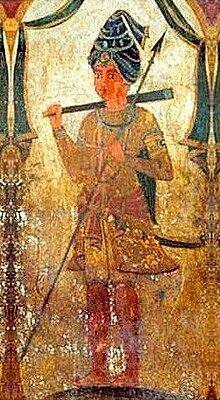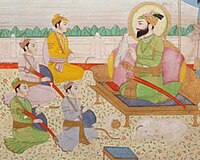Fateh Singh (Sikhism)
Sahibzada Baba Fateh Singh Ji | |
|---|---|
ਫ਼ਤਿਹ ਸਿੰਘ, ਸਾਹਿਬਜ਼ਾਦਾ | |
 Old fresco art depicting Fateh Singh, son of Guru Gobind Singh | |
| Title | Sahibzada |
| Personal | |
| Born | 12 December 1699 |
| Died | 26 December 1705 (aged 6) Sirhind |
| Cause of death | Extrajudicial execution |
| Religion | Sikhism |
| Parents |
|
| Known for | Progenitor of Nihangs/Akalis |
| Relatives | Ajit Singh (half-brother)
Jujhar Singh (brother) Zorawar Singh (brother) |
Fateh Singh Rai (Gurmukhi: ਫਤਿਹ ਸਿੰਘ ; 12 December 1699 – 26 December 1705), also referred to with honorifics as Sahib Baba Fateh Singh or Sahibzada Baba Fateh Singh was the fourth and youngest son of Guru Gobind Singh. The honorary prefix, Baba is considered as Learned or Respected, while Sahibzada means the "Prince". Fateh Singh and his elder brother Zorawar Singh Rai are among the most hallowed martyrs in Sikhism.
Biography

Fateh Singh was born in Anandpur Sahib on 12 December 1699, the fourth son of Mata Jito, Guru Gobind Singh Ji's first wife. His mother died when he was one year old, and he and his brother Zorawar Singh were cared for by their grandmother, Mata Gujari, until their martyrdom.[1]
In May 1705 a combination of Mughals and hillmen besieged Anandpur Sahib on the orders of Mughal emperor Aurangzeb. For several months the Sikhs withstood the attacks and blockade, but eventually the stock of food in the town ran out. The Mughals offered the Sikhs safe exit if they left Anandpur. Guru Gobind Singh agreed and evacuated the town with his family and a small band of retainers. Mata Gujari and the two boys were brought by the family's servant Gangu to his native village of Sahedi. Bribed by the Mughals, he turned over the three members of Guru Gobind Singh's family to the faujdar of Sirhind. They were then brought to the Nawab Wazir Khan (Sirhind) in Sirhind. The two sons of Guru Gobind Singh, Zorawar (9 years old) and Fateh (6 years old) were offered safe passage if they became Muslims. With a courage that belied their years, both boys refused to do so. Wazir Khan sentenced them to death. They were bricked up alive within a wall.[2] Gurudwara Bhora Sahib marks the site of the wall in Gurdwara Fatehgarh Sahib.
After Guru Gobind Singh's death, Banda Singh Bahadur, born Lachman Dev, also known as Banda Bairagi and Gurbaksh Singh, took revenge on those who had taken part in the deaths of the children. After defeating the Mughals in the Battle of Samana and Battle of Sadhaura he conquered Samana and Sandhaura, he moved towards Sirhind and after defeating the Mughal forces in the Battle of Chappar Chiri, the Sikh army conquered Sirhind. In the battle, Wazir Khan (Sirhind) was beheaded.[3]
First Akali-Nihang


According to Sikh tradition, Fateh Singh was the first Nihang warrior and inspired the traditions of the Nihang sect. [4]
Fateh Singh Ke Jathe Singh
This war cry is mainly used by the Akali Nihangs. In Sikh tradition, it is believed that when Wazir Khan asked Fateh Singh, who he had imprisoned, what he would do if freed, Fateh Singh replied with a speech, ending it with "Fateh Singh Ke Jathe Singh", meaning that he would gather an army and fight against him and all oppressors, preaching a core value of Sikhism. [citation needed]
Commemoration
Fatehgarh Sahib-Sirhind is a city based in central Punjab named after Fateh Singh. Punjab Chief Minister Amarinder Singh on Friday urged Prime Minister Narendra Modi to institute a National Bravery Award in the name of Fateh Singh and issue a commemorative gold coin to honour of Diwan Todar Mal, in tribute for their sacrifices.[5]
See also
- Ajit Singh (brother)
- Jujhar Singh (brother)
- Zorawar Singh (brother)
- Guru Gobind Singh (father)
- Mata Jito (mother)
- Guru Tegh Bahadur (grandfather)
- Mata Gujri (grandmother)
References
- ^ Shamsher Singh Ashok. "FATEH SINGH SAHIBZADA(1699-1705)". Encyclopaedia of Sikhism. Punjabi University Patiala. Retrieved 27 March 2016.
- ^ Singh, Patwant (2001). The Sikhs by Patwant Singh. ISBN 9780385502061.
- ^ Syad Muhammad Latif (1984), History of the Panjab from the Remotest Antiquity to the Present Time, Progressive Books, p. 274
- ^ "Neela Bana – Blue Uniform of the Nihang Singh". SikhNet. Retrieved 28 October 2020.
- ^ ANI (6 March 2020). "Punjab CM urges PM Modi to institute a National Bravery Award to honour Sahibzada Baba Fateh Singh". Business Standard India. Retrieved 29 October 2020.
